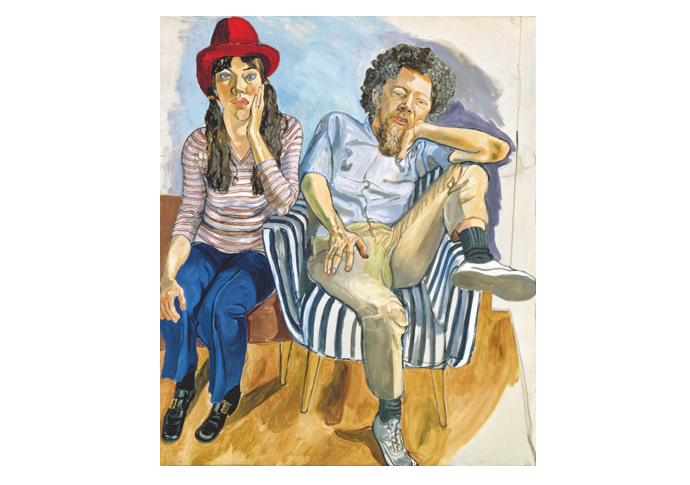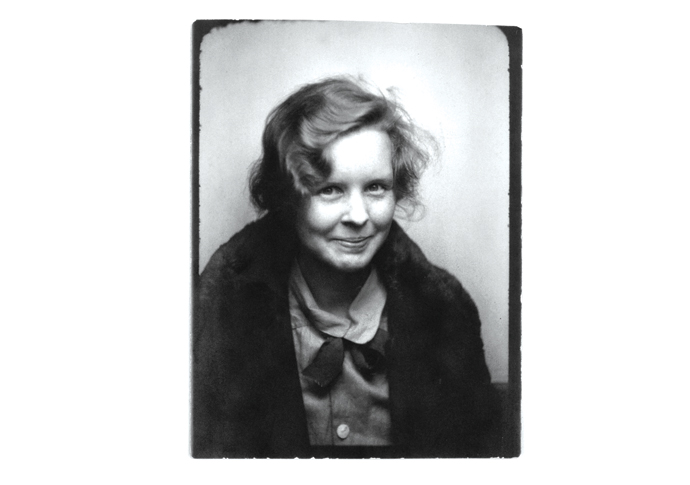Hot! Hot! Hot!
The largest exhibition held in the UK of Alice Neel’s works is currently on show at the Barbican. Jane Clinton goes in search of the artist who wanted to capture life ‘hot off the griddle’
Thursday, 9th March 2023 — By Jane Clinton

Benny and Mary Ellen Andrews, 1972 [The Estate of Alice Neel. Courtesy The Estate of Alice Neel]
A MAN and a woman gaze languidly from the canvas, an air of dreamy lethargy surrounding them. It was painted by the US artist Alice Neel, now the subject of a Barbican exhibition, Alice Neel: Hot Off The Griddle – the largest of her work to date held in the UK.
Born in 1900, she was painting bold, striking portraits at a time when it was deemed deeply unfashionable to do so. Her sitters were also not those typically painted and included pregnant women, black people and children from her neighbourhood.
She made people her painting passion, once joking she should have been a psychiatrist as she “love[d] plumbing the depths of the human psyche”.
Neel also had what she believed was the perfect mix of qualities to be an artist: “hypersensitivity and the will of the devil”. Her hypersensitivity would deftly capture the interior world of her subjects.
Neel explained: “One of the reasons I painted was to catch life as it goes by, right hot off the griddle…”
Born in Pennsylvania, Neel wanted to be an artist from an early age but her mother was unconvinced, insisting: “you’re only a girl”.
Despite this, she went to study at the Philadelphia School of Design for Women. Then in 1924 during a summer school, she met the Cuban artist and son of a wealthy family, Carlos Enríquez. They married in 1925 and later moved to Havana.
There followed a prodigious period for the pair, whose work was well-received in Cuba.
Neel gave birth to their daughter Santillana del Mar in 1926 and she and her baby moved to the US in 1927 with Enríquez following. But tragedy struck when Santillana died of diphtheria.
After a second daughter Isabetta was born in 1928 and with little money, the marriage was strained.
Then in 1930, after Isabetta was taken by Enríquez to Cuba to live with his family, Neel had a mental collapse.She spent a year in psychiatric care, including stays on suicide wards. Art would be central to her recovery.

Alice Neel aged 29 in 1929 [The Estate of Alice Neel. Courtesy The Estate of Alice Neel]
She set up home in Greenwich Village where she painted the beatnik community and was described as “the court painter of the underground”.
Through her relationship with a sailor, Kenneth Doolittle, she met members of the Communist Party USA – a party to which she would become a member in 1935.
However, Doolittle, an opium smoker, was volatile and would become enraged with jealousy if Neel received male attention.
In 1934, during one such episode, he burned more than 300 of her works on paper and slashed about 60 of her paintings. Despite this devastating loss, Neel carried on and painted political events such as an anti-fascism march in 1936 (which she also went on), as well as the Uneeda Biscuit Strike in the same year.
A picture of Lenin remained on her kitchen wall throughout her life, but when asked about her politics, she described herself as “an anarchic humanist”.
In 1938 Neel moved to Spanish Harlem with José Negrón, a nightclub singer. They had a son, Richard, but Negrón left when he was only three months old.
As a single mother living a financially precarious existence, Neel brought a sensitivity to the portraits of those subjects similarly affected, including a boy called Georgie Arce whom she would paint several times.
She would go on to portray those around her from the local taxi driver, Abdul Rahman to Andy Warhol to the bohemian intellectuals she encountered. The ordinary, the famous, and the learned all resided cheek by jowl in Neel’s world.
Throughout the 40s and 50s, she also painted people she admired for their political activity, including the Marxist filmmaker Sam Brody, who became her partner and with whom she had a son, Hartley.
Neel’s political interests were noted by authorities and she was investigated by the FBI, with their files describing her as “a romantic, Bohemian-type communist”.
When two FBI agents came to interview her she was entirely unfazed and asked them if they would sit for a portrait. Unsurprisingly they declined.
With the rise of social justice movements and second-wave feminism in the 1960s and 1970s Neel’s work eventually gained wider recognition.
The first meaningful appreciation of her art would be written in 1962 when she was in her 60s. There followed many solo shows including a major retrospective at Whitney Museum of American Art in 1974.
In 1976 she said: “I paint to try to reveal the struggle, tragedy and joy of life.”
Neel died of cancer in 1984 aged 84.
And what of that dreamy couple she painted, Benny Andrews, fellow artist and an activist, and his wife Mary Ellen Andrews?
He said of being painted by Neel: “She lulled you… she was looking at you like an X-ray, and you were sitting up there laughing at her jokes while she was seeing right through you.”
• Alice Neel: Hot Off The Griddle is at the Barbican until May 21,2023. Tickets from https://www.barbican.org.uk/AliceNeel